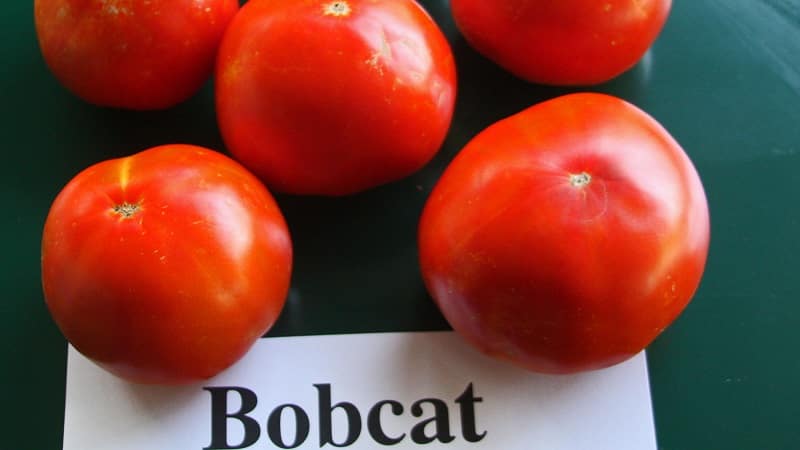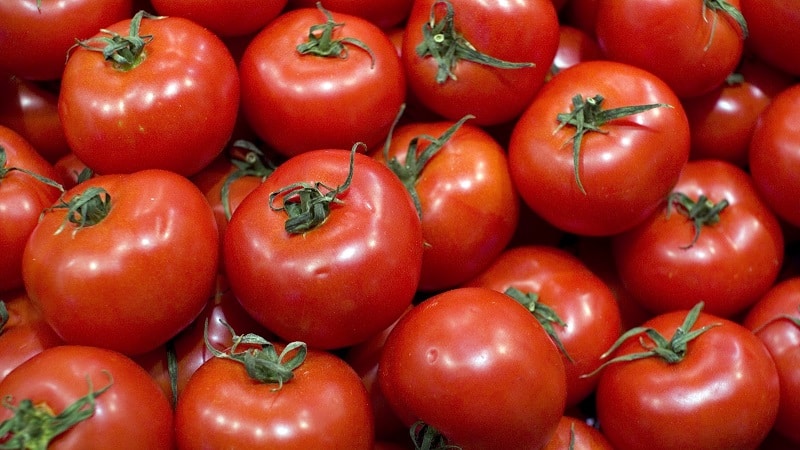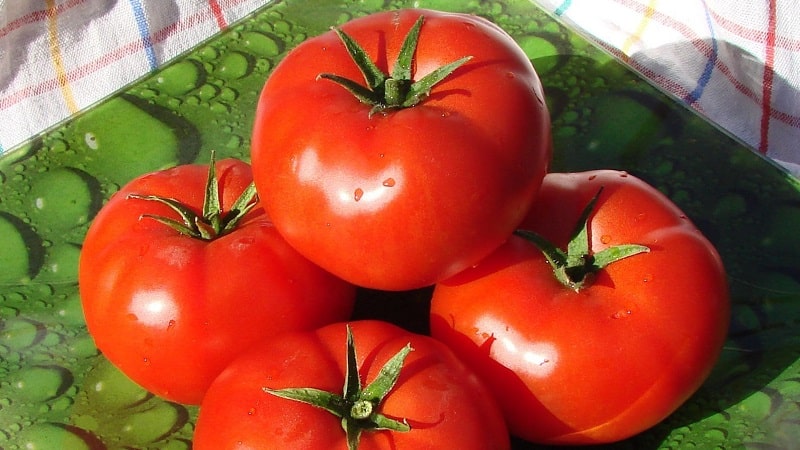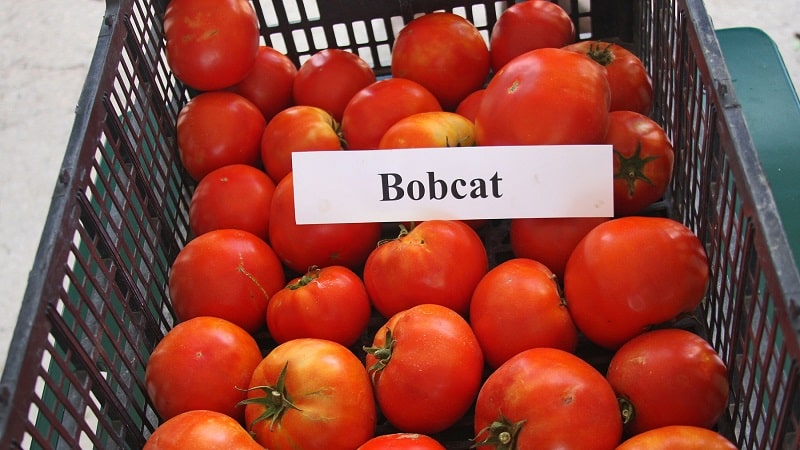Why every gardener should grow a Bobcat tomato at least once - the best of the low-growing ones
Both beginners and experienced gardeners want to get a harvest of tasty and beautiful tomatoes without spending a lot of time caring for them. Previously, this was impossible, since tomatoes are a capricious crop, the cultivation of which in our country was associated with many difficulties. However, selection does not stand still. Thanks to the efforts of agronomists, today many varieties have been developed that are easy to care for.
One of the varieties that delight tomato lovers with beautiful, tasty and large fruits is the Bobcat tomato. It has been popular in our country for many years. What is so good about this hybrid? In the article we will give a detailed description and description of the variety.
Description of the hybrid
Bobcat is a hybrid variety of tomatoes, as indicated by the designation F1. It was bred by Dutch breeders. Appeared on the Russian market in 2008. Since then, the popularity of tomato culture has not diminished.
The hybrid produces large red fruits of the same shape and size throughout the entire fruiting period. They have good transportability due to their thick skin.
The bobcat was bred for growing in hot regions. In the south of the country it thrives in open ground. In the northern part of Russia it is necessary to use greenhouses.
Refers to determinant cultures. On average, a healthy bush reaches a height of 50-70 cm, the maximum can grow up to 1.2 m.
Reference. Determinate tomatoes are those that stop growing as soon as a fruitful ovary appears on their top.
Peculiarities
The Bobcat tomato is a large-fruited hybrid. It produces large fruits of uniform red color with a shiny shell (see photo). The weight of one tomato can reach 300 grams.
Tomatoes have a sweet and sour taste, a high percentage of dry matter (5.5-6.5%) and loose pulp.
Thanks to their thick skin, tomatoes are excellent for canning; they do not crack or change shape. They are also suitable for fresh consumption, which makes the variety universal.
Bobcats are immune to the most common nightshade diseases. This greatly facilitates its care and reduces the need to use chemicals to treat bushes.
The crop's yield is average. At the same time, Bobcat is resistant to temperature changes and will delight you with the harvest until the first frost.
The table below shows the main characteristics of the variety.
| Parameter | Indicators |
| Bush type | Determinant. On average, the height of the bush reaches 50-70 cm. The stems and greenery are powerful and dense. Up to 6 ovaries are formed on one stem, after which the plant stops stretching upward |
| Growing method | Suitable for growing in open and protected ground. The first method is used in the southern regions of the country, and the second - in Siberia and the northern regions |
| Productivity | Average. From 1 sq. m per season you can collect from 4 to 6 kg of fruit. Experienced gardeners say that with proper care you can achieve results of 8 kg |
| Fruit | Red inside and out. They have a dense, shiny, smooth skin. The fruits are round, regular in shape, slightly flattened, and may have slight ribbing at the base.All fruits on the bush are characterized by almost the same shape and size throughout the entire fruiting period. Tomatoes are fleshy with 5.5-6.5% dry matter. May have from 4 to 7 chambers with seeds |
| Transportability | High. Stored for more than a month |
| Ripening time | Mid-season variety. From the appearance of the first shoots to ripening, 115-130 days pass. Resistant to changes in soil temperature, so harvesting can continue until the first frost |
| Disease resistance | Fusarium wilt, verticillium wilt, alternaria blight |
The tomato was bred for growing in arid regions. It has a developed root system and is not afraid of high temperatures. In dry weather and the scorching sun, the fruits do not crack.

Growing seedlings
Before planting tomatoes in the ground, seedlings are grown. This is usually done at home on the windowsill.
Planting material is sown in early or mid-March (times are calculated depending on the region).
Preparing the seeds
Before you start growing seedlings, prepare your planting material. Make sure the seeds have not expired. An expired product will have low germination.
Advice. When buying seeds from an unverified seller, ask to see quality certificates and other documents for the goods. This will reduce the likelihood of purchasing a fake.
Seed preparation:
- Sort out the planting material. Remove damaged and blackened seeds.
- Bobcat does not require preliminary disinfection. Therefore, there is no need to treat the seeds with potassium permanganate. To check the germination of seeds, you can soak them in a weak salt solution. The floating material will not rise, so it is removed.
- Before planting, the seeds can be soaked in a growth stimulator. To do this, you need to cut the gauze and moisten it with liquid. The seeds are placed in it for 12 hours.
Important! In March, there may not be enough sunlight for plants, which can lead to their stretching. To avoid this, use phytolamps.

Selecting container and soil
For sowing seeds, it is better to take a large container. This will make it possible to fit all the planting material in one container. At the same time, the pot may not have much depth.
After germination, the plants are planted in individual pots. To do this, you can use ordinary half-liter plastic cups or peat pots.
You need to prepare glass or film with which you will cover the sprouted seeds for the first time.
Important! If you are using a homemade container to start your seeds, be sure to make a few holes in the bottom.
The container is disinfected before use. This will reduce the likelihood of plant infection.
Soil for planting can be purchased at a specialty store. Such soil contains all the necessary microelements.
Homemade soil is also suitable for growing seedlings, but you shouldn’t just take soil from the garden. To provide the plants with the most comfortable conditions, a mixture of turf, humus, peat (1:1:1) is prepared and a glass of ash is added for every 10 kg of the mixture.
Before use, the soil must be disinfected. One of the options for soil disinfection is treatment with a weak solution. potassium permanganate. Calcination at a temperature of 80 degrees can also be used for these purposes.
Sow the seeds
The seeds are planted in a prepared large container. To do this, grooves 1 cm deep are made in pre-moistened soil at a distance of 2 cm from each other. Seeds are placed in the recesses at a distance of 1 cm.
The planting material is sprinkled with a small amount of soil on top. The earth cannot be compacted.
The container with seeds is covered with glass or film and placed on a windowsill or under a phytolamp.
The optimal temperature for seed germination is 25 degrees. To ensure an optimal level of humidity, the film covering the seeds must be opened slightly every day for several hours.

Rules for caring for seedlings
Compliance with all the rules is a guarantee that you will grow strong and viable plants.
Rules for caring for seedlings:
- Seeds planted in a common container are moistened as the soil dries. This should be done from a spray bottle with water at room temperature.
- Two weeks after sowing the seeds, you can remove the film from the container in which they were grown.
- When true leaves form on the plants, they are transplanted into separate containers. If the root of the plant is too long, then the lower fragile part can be pinched off. This will allow the plant to take root better.
- After pinching down one-third of the plant roots, their growth may temporarily slow down. There is no need to be afraid of this, since in the future the indicators will normalize, and the plant will be more resilient and strong.
- Tomatoes placed in individual containers are watered with water from a watering can. This must be done carefully so as not to wet the greens.
- A week after picking the seedlings into separate pots, they are fed with compositions based on vermicompost.
- Two weeks before planting tomatoes in the ground, you need to start hardening them. Pots with Bobcat are taken out onto the balcony or street during the warm time of the day. You need to start with 15 minutes, gradually increasing the time to the whole day.

Cultivation of tomatoes
Bobcat cultivation is possible both in a greenhouse and in open ground. This depends on the region where you live.
Tomatoes are planted in open ground in early or mid-June. Plants can be placed in the greenhouse as early as the end of May.
Planting seedlings in the ground
Before planting Bobcat in a permanent place, you need to prepare the soil. In order to prevent plant diseases, the soil is treated with copper sulfate, then fertilized with compost and ash.
Tomatoes are planted in a checkerboard pattern. The distance between Bobcat bushes should be at least 60 cm, since this variety has a developed root system.
How to transplant seedlings into the ground:
- Holes are made in the soil at the required distance (the diameter of the hole is the width of the shovel). They are watered abundantly.
- Wait until the water soaks into the soil before planting.
- At this time, water the seedlings themselves generously - this will make it easier to remove.
- Remove the tomato from the pot along with the soil. It is important not to damage the root system.
- The seedling is placed in the hole, holding the roots with the ground in the process. The stem is buried a couple of centimeters.
- The holes are covered with earth and compacted carefully.

Plant care
There is no need to pinch the top of the Bobcat tomato. The plant stops stretching upward after the formation of fruiting clusters.
The tomato is formed into 1-3 stems. The more stems, the more abundant the harvest will be, but the later the first fruits will appear. Typically, gardeners choose the tactic of forming 2 bushes.
Stepsoning Tomato production must be done regularly so that the plant does not drop its flowers with the ovary. To do this, remove all the shoots that have formed under the brushes. To do this, you need to break off the shoot in one motion.
Important! The bobcat has rather heavy fruits and, despite its short stature, needs a garter. For these purposes, a meter peg is enough.
Plants should be watered 1-2 times a week. The frequency of soil moisture directly depends on the weather.
Tomatoes are fertilized with complex fertilizers once every two weeks. For tomatoes, it is better to choose formulations in which the amount of nitrogen is less than the percentage of potassium and phosphorus. It is necessary to use fertilizers based on magnesium.
When the plant begins to bloom, apply boron fertilizers. The dosage and method of use are always indicated on the packaging of these products.
The nuances of growing tomatoes
Knowing some of the nuances of growing tomatoes will allow you to get a good harvest.
Below are the most important of them:
- You can protect bushes from pests, diseases and drying out roots by mulching. The beds are covered with straw, hay, compost, burlap or film.
- On hot summer days, it is better not to carry out pinching, as this can become very stressful for the plant. Plants tolerate such manipulations better in rainy, cloudy weather. Watering on the day of pinching is also prohibited.
- Bobcat bushes need to be watered at the root. Getting water on the leaves will increase the risk of plant infection.
- For irrigation, you should not use water from a well or borehole. Tomatoes are watered with settled water at outside temperature.
Diseases and pests
The Bobcat tomato is resistant to verticillium, Fusarium wilt and Alternaria. Gardeners claim that other diseases affect this variety extremely rarely.
The crop must be protected from insect pests. Nightshades are often affected by aphids, slugs, Colorado potato beetles, mole crickets, etc.
Some pests can be collected by hand.To prevent their appearance, the bushes are treated with a weak soap solution.
You can reduce the likelihood of damage by mole crickets by promptly removing weeds, loosening and mulching the soil.
Attention! Late blight is the most common and dangerous disease of tomatoes. To prevent its occurrence, do not plant Bobcats in beds where the same crop grew last year, and pick ripe fruits in a timely manner.
It is very important to follow the rules glaze. If you flood or allow plants to dry out, the risk of diseases and pests will increase significantly.

Features of growing in protected and open ground
The Bobcat tomato is grown both in protected and open ground. For this variety, the care technology in both cases is not particularly different, but there are still some nuances:
- If the plants are in a greenhouse, then it needs to be ventilated daily by opening the doors and windows.
- When growing tomatoes in a greenhouse, the risk of being damaged by harmful insects is lower than in open ground, but a preventive inspection is still necessary.
- When planting seedlings in open ground, the first time it should be covered with film. This will help prevent the death of plants during night frosts.
Harvesting and application
Bobcat fruits ripen in late July - early August. At this time, you need to regularly harvest.
All ripe tomatoes are picked immediately, preventing the plant from becoming infected. late blight. In rainy weather, green tomatoes that have managed to gain mass are also harvested. They will ripen at home.
Bobcat tomatoes are suitable for fresh consumption, making juices and pastes, as well as canning, since they do not crack or lose their shape in marinade.
Advantages and disadvantages of the variety
Bobcat tomatoes are grown not only for themselves, but also for sale. This culture has many advantages.
Benefits of tomato:
- large fruits of the same size;
- excellent transportability;
- ease of care;
- high temperature resistance;
- resistance to many diseases.
One of the disadvantages of tomato is its heat-loving nature. This hybrid is not suitable for growing in open ground in the northern regions of our country.
Reviews
In general, reviews about the culture are positive, but there are always gardeners who have already found their favorite varieties and therefore greet the hybrid coolly.
Ivanova Irina (Sochi): “I have been raising Bobcats for many years. On average, I harvest 5 kg of tomatoes from one bush. I love that the tomatoes look like a photo on the cover of a magazine. All are the same size, large, shiny and evenly colored. I didn’t encounter any difficulties in care.”
Cabbage Alexey (Klin): “We took Bobcat on the recommendations of friends. They were grown in greenhouse conditions, since the summer was cold. To be honest, I was not impressed. The yield is average, and the taste is sour.”
Galina (Vitebsk): “I liked the Bobcat tomato. The fruits were 600-700 g, they didn’t hurt, I planted them again this year, they were stored for a long time, they were in the greenhouse until October, I took them off when the frosts started.”
Conclusion
The Bobcat tomato is a variety distinguished by large, beautiful fruits with a durable, glossy shell. It can be grown not only in a greenhouse, but also in open ground.
It is this unpretentiousness and immunity to the most common nightshade diseases that makes this hybrid worthy of the attention of experienced and novice gardeners. With it you can get a good harvest without spending a lot of effort, money and time.